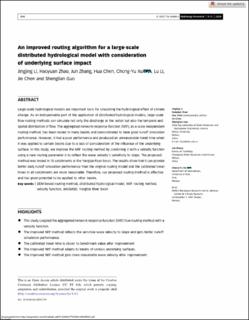| dc.contributor.author | Li, Jingjing | |
| dc.contributor.author | Zhao, Haoyuan | |
| dc.contributor.author | Zhang, Jun | |
| dc.contributor.author | Chen, Hua | |
| dc.contributor.author | Xu, Chong-Yu | |
| dc.contributor.author | Li, Lu | |
| dc.contributor.author | Chen, Jie | |
| dc.contributor.author | Guo, Shenglian | |
| dc.date.accessioned | 2020-12-16T10:22:02Z | |
| dc.date.available | 2020-12-16T10:22:02Z | |
| dc.date.created | 2020-11-18T17:54:55Z | |
| dc.date.issued | 2020 | |
| dc.identifier.citation | Hydrology Research. 2020, 51 (5), 834-853. | en_US |
| dc.identifier.issn | 1998-9563 | |
| dc.identifier.uri | https://hdl.handle.net/11250/2719766 | |
| dc.description.abstract | Large-scale hydrological models are important tools for simulating the hydrological effect of climate change. As an indispensable part of the application of distributed hydrological models, large-scale flow routing methods can simulate not only the discharge at the outlet but also the temporal and spatial distribution of flow. The aggregated network-response function (NRF), as a scale-independent routing method, has been tested in many basins and demonstrated to have good runoff simulation performance. However, it had a poor performance and produced an unreasonable travel time when it was applied to certain basins due to a lack of consideration of the influence of the underlying surface. In this study, we improve the NRF routing method by combining it with a velocity function using a new routing parameter b to reflect the wave velocity's sensitivity to slope. The proposed method was tested in 15 catchments at the Yangtze River basin. The results show that it can provide better daily runoff simulation performance than the original routing model and the calibrated travel times in all catchments are more reasonable. Therefore, our proposed routing method is effective and has great potential to be applied to other basins. | en_US |
| dc.language.iso | eng | en_US |
| dc.rights | CC BY 4.0 | |
| dc.rights.uri | https://creativecommons.org/licenses/by/4.0/ | |
| dc.title | An improved routing algorithm for a large-scale distributed hydrological model with consideration of underlying surface impact | en_US |
| dc.type | Peer reviewed | en_US |
| dc.type | Journal article | en_US |
| dc.rights.holder | © 2020, The Authors. | |
| dc.description.version | publishedVersion | en_US |
| cristin.ispublished | true | |
| cristin.fulltext | original | |
| cristin.qualitycode | 1 | |
| dc.identifier.doi | 10.2166/nh.2020.170 | |
| dc.identifier.cristin | 1849449 | |
| dc.source.journal | Hydrology Research | en_US |
| dc.source.volume | 51 | en_US |
| dc.source.issue | 5 | en_US |
| dc.source.pagenumber | 834-853 | en_US |

